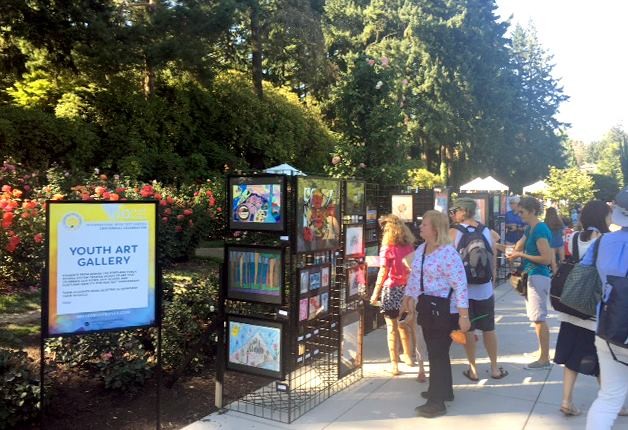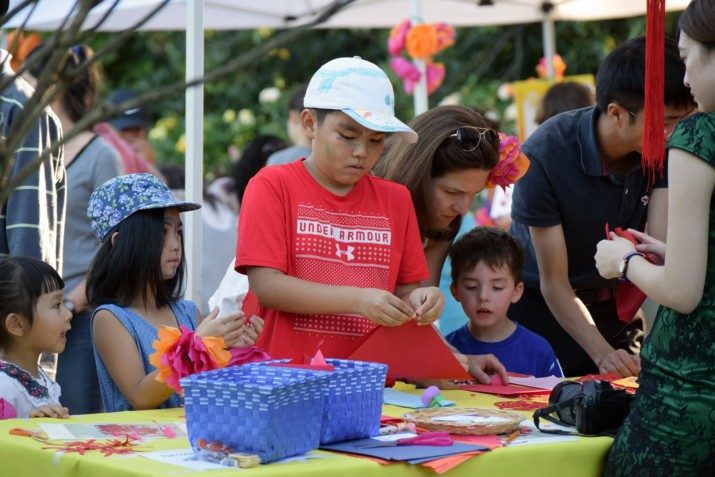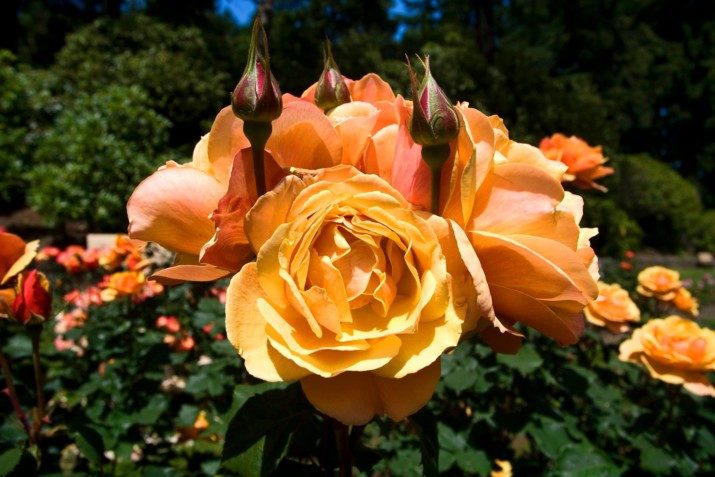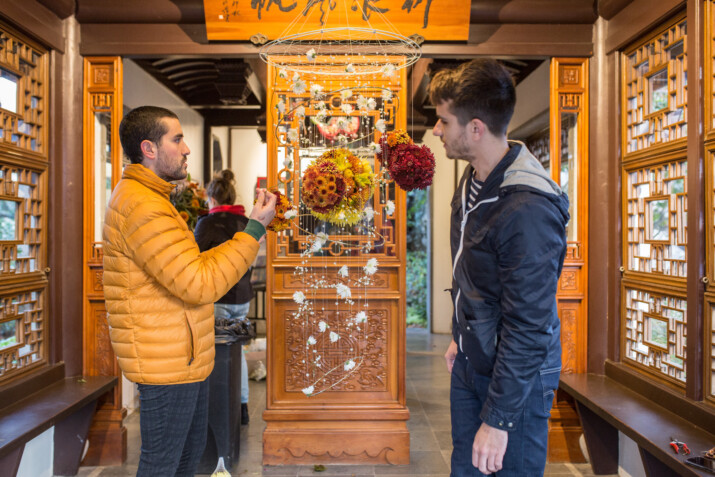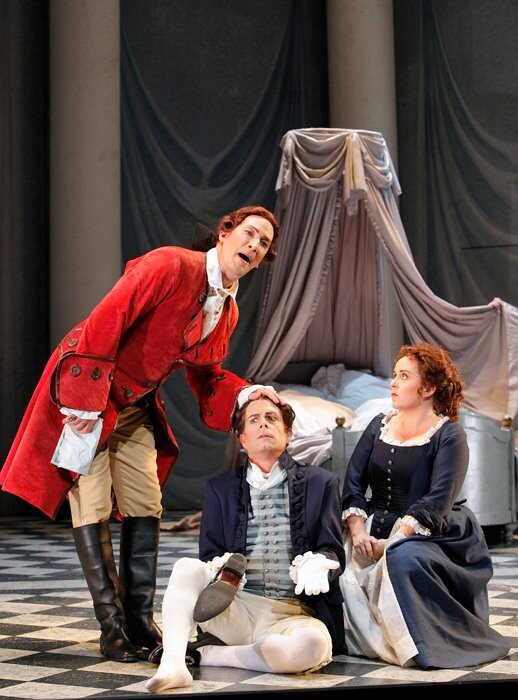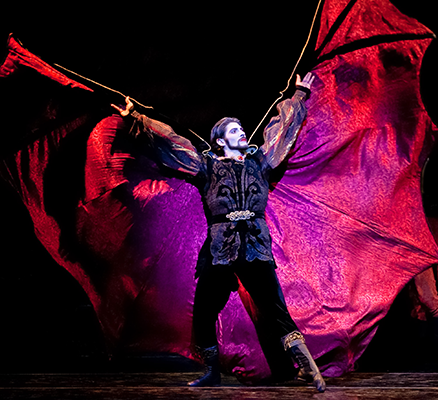Portland, OR. The smell of roses wafted over the crowd celebrating 100 years of roses in Portland. The August 26th event at Washington Park featured rose tours, art displays, rose ice cream from Salt & Straw Ice Cream and a special concert. The 4.5 acre garden is the oldest continuously operating public rose test garden in the United States and helped provide Portland with its nickname: “City of Roses”.
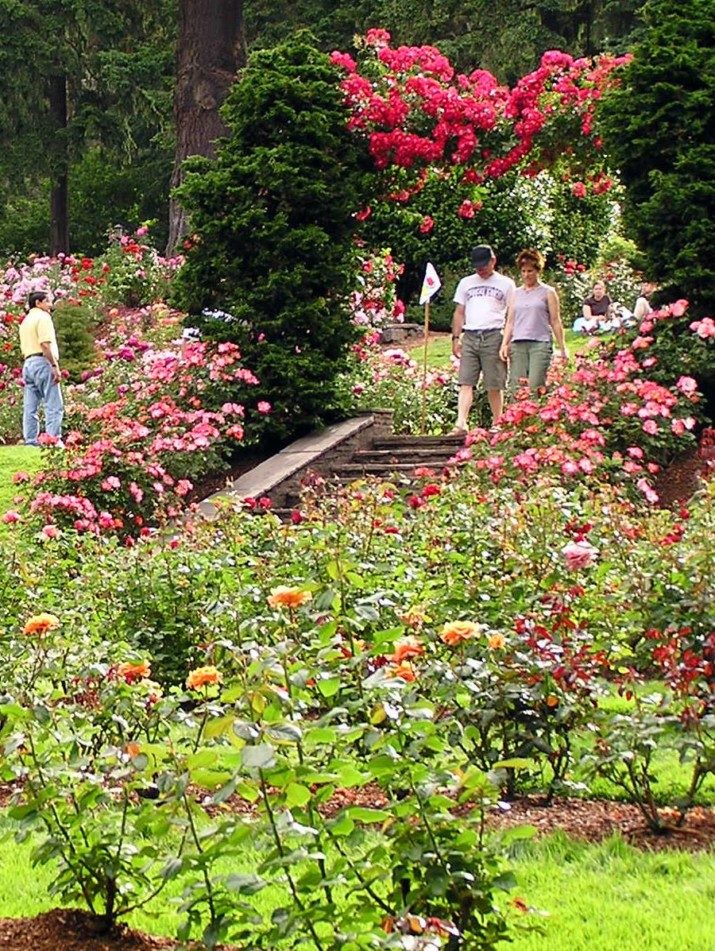
The terraced garden attracts nearly 700,000 visitors a year who revel in sweet scents and sweeping views. There are over 7,000 rose plants of approximately 550 varieties.
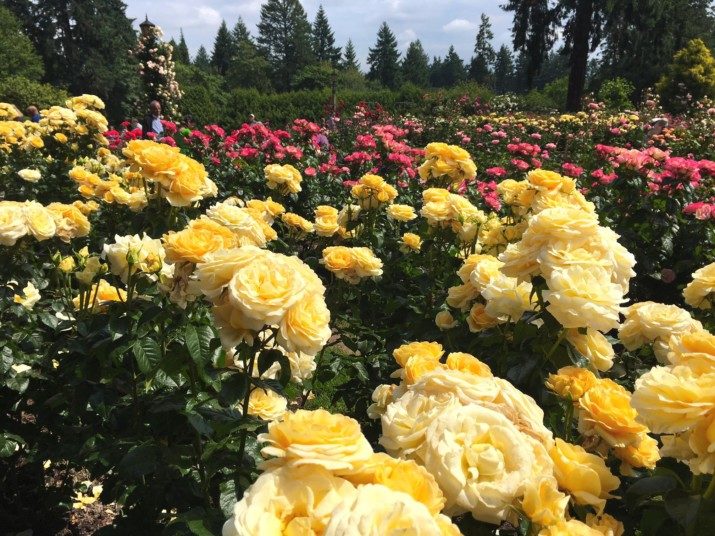
The roses bloom from April through October with the peak coming in June, depending on the weather. New rose cultivars are continually sent to the garden from many parts of the world and are tested for color, fragrance, disease resistance and other attributes.
Here’s more information about Portland’s Rose Garden:
The garden is located in Washington Park, at 400 SW Kingston Avenue.
FREE public tours are offered daily at 1:00pm, from Memorial Day weekend through Labor Day weekend. Meet at the Rose Garden store 10 minutes prior.
SPECIAL NOTICE FOR VISITOR PARKING
Effective September 2016 to March 2018, parking is extremely limited in Washington Park due to a multi-year Portland Water Bureau project. Visitors are encouraged to take TriMet MAX Light Rail to Washington Park to avoid delays in parking. Visit explorewashingtonpark.org for further information on parking and the free shuttle bus that runs throughout the park. Find out more about the Reservoir Improvements Project at Washington Park.
Tour Groups
Guided tours for groups of 11 or more are available during the year for a nominal fee per person. Call 503-823-3664 to make arrangements.
Visit the Rose Garden Store website at www.rosegardenstore.org.
The American Garden Rose Selections organization has eleven test sites nationally:
- Portland International Rose Test Garden
- Orangeburg, SC
- San Jose, CA
- Farmer’s Branch ,TX
- Baton Rouge, LA
- Kennewick, WA
- Westfield, MA
- Columbus, OH
- Glencoe, IL
- Ames, IA
- Lexington, KY
Founded in 1889, the Portland Rose Society is a nonprofit organization offering educational programs on rose culture and encouraging the use of roses in the landscape. For information on Rose Society programs or membership, write or call Portland Rose Society, PO Box 515, Portland, 97207, voice mail: 503-777-4311.
Volunteer opportunities are available in both garden and non-garden work. Garden tasks include deadheading, planting, pruning, sign painting, and garden improvement projects. Non-garden tasks include strategic planning, fundraising, updating educational materials, leading garden tours, maintaining inventory records, and coordinating volunteer efforts. Contact the Rose Garden, 503-823-3636 or Volunteer Services, 503-823-5121.
Portland has long had a love affair with roses. In 1888, Georgiana Burton Pittock, wife of publisher Henry Pittock, invited her friends and neighbors to exhibit their roses in a tent set up in her garden; thus the Portland Rose Society was established.
Madame Caroline Testout was a late 19th century French dressmaker from Grenoble, the proprietor of fashionable salons in London and Paris. She regularly purchased silks from Lyon, which was an important center for rose breeding. The nurseryman Joseph Pernet-Ducher was called ‘The Wizard of Lyon’ due to his success in developing hybrid tea roses. Madame Testout was an astute businesswoman and understood the value of good publicity. She asked Perner-Ducher to name one of his new roses after her. He agreed, but considered her choice of seedling to be mediocre. The ‘Madame Caroline Testout’ rose made its debut at the salon’s 1890 spring fashion show. It was not strong on scent, but became an immediate success with Madame Testout’s well to do customers as well as the gardening public for its abundant silky, rose-pink flowers. The new variety’s popularity spread to America, and in Portland, nearly half a million bushes of ‘Caroline Testout’ were planted along the sidewalks. By 1905 Portland had 200 miles of rose-bordered streets which helped attract visitors to the Lewis and Clark Centennial celebration. Portland came to be known as the ‘City of Roses’.
In 1915 Jesse A. Currey, rose hobbyist and Sunday editor of the Oregon Journal, convinced city officials to institute a rose test garden to serve as a safe haven during World War I for hybrid roses grown in Europe. Rose lovers feared that these unique plants would be destroyed in the bombings. The Park Bureau approved the idea in 1917 and by early 1918, hybridists from England began to send roses. In 1921 Florence Holmes Gerke, the landscape architect for the city of Portland, was charged with designing the International Rose Test Garden and the amphitheatre. The garden was dedicated in June 1924. Currey was appointed as the garden’s first rose curator and served in that capacity until his death in 1927.
Part of the original design, the Royal Rosarian Garden is home to the namesake roses of all past Prime Ministers of the Royal Rosarians, a civic group which serves as the official greeters and goodwill ambassadors for the City of Portland. Founded in 1912, the Order of Royal Rosarians modeled their mythical ‘Realm of Rosaria’ after the government of England’s King Henry VII, whose rise to the throne in 1485 ended the War of the Roses. Members are ‘knighted’ into the organization under their chosen variety of rose, which is then their ‘namesake’ rose. The garden also features a stone bench honoring Jesse Currey.
In 1945, the Shakespeare Garden, located at Crystal Springs Lake in southeast Portland, was moved to Washington Park to allow for expansion of Eastmoreland Golf Course. Designed by Glenn Stanton and Florence Gerke, it was originally intended to include only herbs, trees, and flowers mentioned in William Shakespeare’s plays. The garden continues to honor the Bard with roses named after characters in his plays. The focal point of the garden is the Shakespeare Memorial, a brick wall with a plaque featuring Shakespeare’s image and his quote, “Of all flowers methinks a rose is best.” Donated by the LaBarre Shakespeare Club, it was dedicated on April 23, 1946 – the 382nd anniversary of Shakespeare’s birth. In 1957 the club added a sundial to the garden.
In 1967, rose curator Rudolph Kalmbach wanted to establish a formal garden featuring Gold Award roses. (In 1919 the City of Portland issued its first annual Gold Award for the best new rose variety.) With the support of the Portland Rose Society, Wallace Kay Huntington was selected to design the garden which was dedicated in June 1970. In 1991, the Portland Rose Society donated the pavilion which overlooks these award-winning roses.
Established in 1975, the Miniature Rose Garden is one of only six testing grounds for the American Rose Society (ARS) miniature rose test program. The national annual winners from both ARS and AARS associations are displayed in the middle of the garden along the center aisle.
Set in a sunken section on the upper level of the garden, the Frank Beach Memorial Fountain was dedicated in June 1975. The stainless steel sculpture, titled Water Sculpture, was designed and built by Oregon artist Lee Kelly. The fountain was a gift from the Beach family to honor their father, Frank Edwin Beach (1853-1934), the man who is said to have christened Portland the ‘City of Roses’ and who first proposed the annual Rose Festival.
Awards
The award called Portland’s Best Rose was established in 1996. Rose experts from around the world attend a one-day judging in June and select the best rose that day from thousands of submissions. Portland remains the only North American city to issue such an award.



